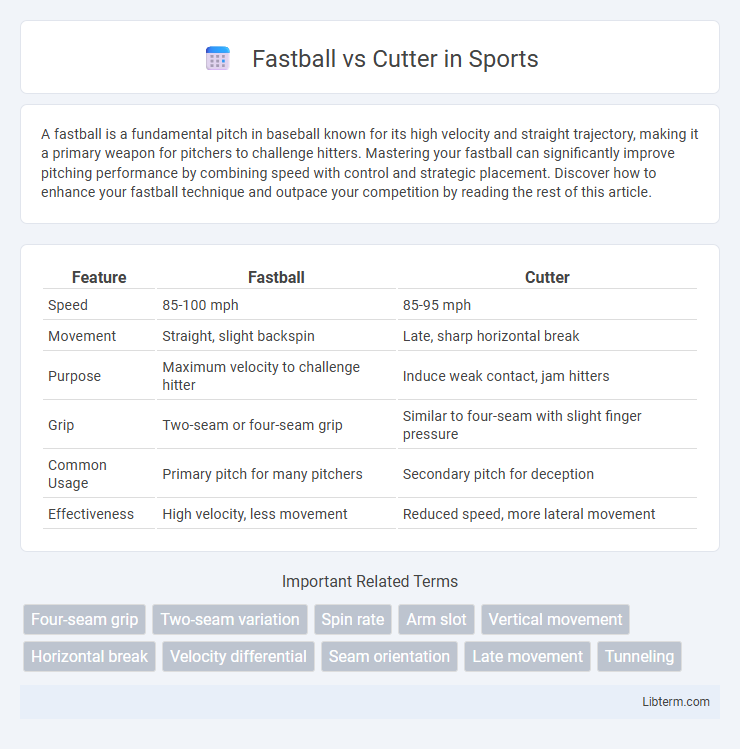A fastball is a fundamental pitch in baseball known for its high velocity and straight trajectory, making it a primary weapon for pitchers to challenge hitters. Mastering your fastball can significantly improve pitching performance by combining speed with control and strategic placement. Discover how to enhance your fastball technique and outpace your competition by reading the rest of this article.
Table of Comparison
| Feature | Fastball | Cutter |
|---|---|---|
| Speed | 85-100 mph | 85-95 mph |
| Movement | Straight, slight backspin | Late, sharp horizontal break |
| Purpose | Maximum velocity to challenge hitter | Induce weak contact, jam hitters |
| Grip | Two-seam or four-seam grip | Similar to four-seam with slight finger pressure |
| Common Usage | Primary pitch for many pitchers | Secondary pitch for deception |
| Effectiveness | High velocity, less movement | Reduced speed, more lateral movement |
Introduction to Fastballs and Cutters
Fastballs are high-velocity pitches typically ranging from 90 to 100 mph, designed to overpower hitters with speed and straight trajectory. Cutters, or cut fastballs, are variations of the fastball that break slightly away from the pitcher's arm side, usually thrown 2 to 5 mph slower than a standard fastball. Both pitches are essential tools for pitchers to manipulate batter timing and induce weak contact.
Key Differences Between Fastball and Cutter
The fastball is a pitch characterized by its high velocity and straight trajectory, typically ranging between 90-100 mph, aimed at overpowering hitters with speed. The cutter, or cut fastball, maintains similar velocity but features a late, subtle horizontal movement that breaks toward the pitcher's glove side, designed to jam hitters and induce weak contact. While fastballs prioritize raw speed and minimal movement for strikeouts, cutters use lateral movement to disrupt timing and batter's swing mechanics.
Mechanics of Throwing a Fastball
The mechanics of throwing a fastball involve a strong push off the back leg, keeping the arm angle consistent, and snapping the wrist at release to generate maximum velocity and backspin. Proper fastball delivery requires a balanced stride with controlled shoulder rotation to maintain accuracy and reduce arm stress. Efficient energy transfer from the lower body through the torso and arm is crucial for achieving high-speed pitches while minimizing injury risk.
Mechanics of Throwing a Cutter
The mechanics of throwing a cutter involve a slight adjustment in grip, where the pitcher positions their index and middle fingers slightly off-center on the ball to create subtle lateral movement. The wrist action remains firm but with a slight pronation at release, generating a cutting motion that moves the ball toward the pitcher's glove side. This combination of grip and wrist pronation differentiates the cutter from a fastball, producing a pitch that mimics fastball velocity but with late movement that confounds hitters.
Speed Comparison: Fastball vs Cutter
A fastball typically ranges between 90 to 100 mph, making it one of the fastest pitches in baseball, while a cutter (cut fastball) usually clocks in slightly slower, around 85 to 95 mph. The cutter's velocity is designed to deceive hitters by mimicking the fastball speed but with late movement, creating a sharp break toward the glove side. This subtle difference in speed combined with movement distinguishes the cutter from the straight, high-velocity fastball.
Movement and Break: Fastball vs Cutter
A fastball typically exhibits a straight trajectory with minimal lateral movement, relying on velocity to challenge hitters. In contrast, a cutter features a sharp, late-breaking movement that veers slightly inward or away from the batter, creating deception and inducing weak contact. The cutter's subtle horizontal break sets it apart from the fastball's more direct, vertical path, making it an effective pitch for disrupting timing and balance.
When to Use a Fastball Versus a Cutter
A fastball is most effective when aiming for maximum velocity and straight trajectory to challenge hitters early in the count or when setting up other pitches. A cutter is best used to induce weak contact or jam hitters, particularly when pitching inside to disrupt their timing and prevent solid barrel contact. Choosing between a fastball and cutter depends on the batter's stance, count situation, and the pitcher's strategic goal to either overpower or finesse the hitter.
Notable Pitchers Known for Fastball and Cutter
Notable pitchers known for their fastball include Aroldis Chapman, whose fastball consistently exceeds 100 mph, and Nolan Ryan, famous for his powerful fastball dominance throughout his career. Mariano Rivera stands out as the premier cutter pitcher, revolutionizing the pitch with unparalleled control and velocity, cementing his legacy as the all-time leader in saves. Other cutters specialists include Josh Beckett and Francisco Rodriguez, who leveraged the cutter to enhance their strikeout capabilities and induce weak contact.
Batter Reaction and Hitting Strategies
Batters often react differently to fastballs versus cutters due to the pitch's distinct movement and speed; fastballs typically rely on straight velocity while cutters exhibit late, sharp lateral break that can jam hitters. Effective hitting strategies against fastballs emphasize timing and power, aiming to drive the ball with a level swing, whereas cutters require adjusting the bat angle and hitting slightly earlier to counteract the glove-side movement. Recognizing the pitch type early through visual cues and release point observation enhances a batter's ability to predict and react, improving contact quality and reducing swings and misses.
Choosing the Right Pitch: Fastball or Cutter
Choosing the right pitch between a fastball and a cutter depends on the hitter's weaknesses and the game situation. The fastball offers maximum velocity and consistent control, making it ideal for overpowering batters or setting up other pitches. The cutter adds movement by slicing away from the hitter's sweet spot, improving strikeout potential against batters who excel at tracking straight pitches.
Fastball Infographic

 libterm.com
libterm.com